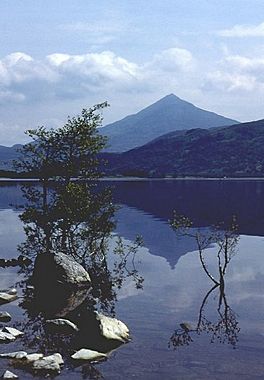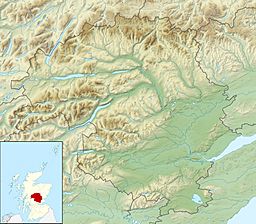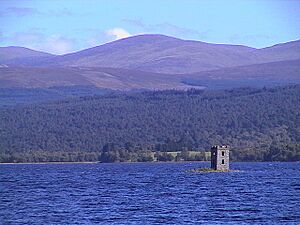Loch Rannoch facts for kids
Quick facts for kids Loch Rannoch |
|
|---|---|

Looking towards Schiehallion
|
|
| Location | Perth and Kinross |
| Coordinates | 56°40′59″N 4°18′50″W / 56.68306°N 4.31389°W |
| Type | freshwater loch |
| Primary outflows | River Tummel |
| Max. length | 15.69 km (9.75 mi) |
| Max. width | 1.21 km (0.75 mi) |
| Average depth | 51.1 m (167.5 ft) |
| Max. depth | 130 m (440 ft) |
| Water volume | 0.97 km3 (0.23 cu mi) |
Loch Rannoch (in Scottish Gaelic: Loch Raineach) is a beautiful freshwater loch in Perth and Kinross, Scotland. It stretches over 15 kilometres (9.3 mi) from west to east. The loch is about 1.2 kilometres (0.75 mi) wide on average. It is deepest at its eastern end, reaching a depth of 130 metres (440 ft).
The River Tummel starts at the eastern end of Loch Rannoch. Here, you will find the small village of Kinloch Rannoch. To the west of the loch lies the vast, wild area known as Rannoch Moor. Long ago, this whole area was part of the ancient Caledonian Forest. This huge forest once covered much of Northern Scotland.
Today, most of the native forest is gone. This happened because of logging and changes in the climate. Now, Loch Rannoch is mostly surrounded by tree farms and open hills. However, a special part of the old forest still remains. It is called the Black Wood of Rannoch, and it's on the southern shore.
Loch Rannoch is also part of a special place called the Loch Rannoch and Glen Lyon National Scenic Area. Scotland has 40 such areas. They are chosen for their amazing natural beauty. This helps protect them from buildings or other changes that could harm their scenery.
Contents
Fun Things to Do at Loch Rannoch
The area around Loch Rannoch is great for visitors! You can find lots of information on the Rannoch and Tummel Tourist Association website.
Fishing in the Loch
Loch Rannoch is a good spot for fishing. You can catch different kinds of fish here. These include brown and ferox trout, arctic charr, pike, and perch. However, there are no salmon in the loch.
Fishing is managed by the Loch Rannoch Conservation Association. They give out permits to fish. They also make sure people follow rules about how many fish they can catch. This helps protect the fish for the future.
Exploring Tay Forest Park
Some of the forests around Loch Rannoch belong to Forestry and Land Scotland (FLS). These forests are part of the Tay Forest Park. This park is a group of FLS forests in the Highland parts of Perthshire. They are managed to offer nice walks and places for visitors to enjoy nature.
History and Old Buildings
Loch Rannoch has some interesting historical sites. These places tell us about the past.
The Crannog on Eilean nam Faoileag
There is an old island home called a crannog on Eilean nam Faoileag. This island is in the western part of the loch. In the 1800s, a Baron Granbley supposedly built a folly here. A folly is a building made just for fun, not for a real purpose. This folly is a tower, and it might look like a small island prison.
There might be another crannog at Eilean Beal na Gaoire. This is at the very western end of the loch. But the water level of the loch has risen. This means the island is now underwater. So, experts are not sure if it is a crannog.
Mary, Queen of Scots and the Island House
Mary, Queen of Scots visited the area long ago. On August 3, 1564, she wrote a letter. She asked Colin Campbell of Glenorchy to destroy a strong house. This house was on an island in the loch. The Clan Macdonald of Clanranald was rebuilding it. Her father, King James V, had ordered it to be torn down before.
Getting Around Loch Rannoch
Loch Rannoch was once part of a very old travel route.
The Historic Road to the Isles
The famous "Road to the Isles" used to go along Loch Rannoch. This road connected Pitlochry to Lochaber. Pitlochry was on the main road between Stirling and Inverness. Loch Rannoch is even mentioned in the Scottish folk song named after this road.
Today, this road is called the B846. It runs along the north shore of the loch. The road ends at Rannoch railway station. This station is on the West Highland Line. It is about 5+1⁄2 miles (9 km) west of Loch Rannoch. From there, the Road to the Isles continues as an unpaved track.
How Loch Rannoch Helps Make Electricity
Loch Rannoch plays a role in making electricity for homes and businesses.
Rannoch Power Station
Rannoch Power Station is on the northern shore of the loch. It is part of the Tummel hydro-electric power scheme. This scheme uses water to create electricity. The company SSE operates it.
The power station uses water that comes from Loch Ericht. This water travels through pipelines and tunnels. It then falls 156 m (512 ft) to spin turbines. This creates 44 MW of power. The water is then released into Loch Rannoch.
The Black Wood of Rannoch
The Black Wood of Rannoch is a special place. It is a small part of the ancient Caledonian Forest. This wood is on the southern shore of Loch Rannoch.
Protecting Nature at Black Wood
The Black Wood is a Special Area of Conservation (SAC). This means it is protected because of its important plants and animals. It is the largest remaining piece of Caledonian Forest in Perth and Kinross.
The forest is home to some rare plants. These include the coralroot Corallorhiza trifida and serrated wintergreen Orthilia secunda. It also supports special birds. These are the Scottish crossbill and the large capercaillie.
History of the Wood
People have used the Black Wood of Rannoch for timber for almost 200 years. During the Great War, there were plans to cut down all the trees. But that didn't happen.
The Forestry Commission and its current group, Forestry and Land Scotland (FLS), have owned and managed the wood since 1947. FLS manages the wood as a forest reserve. They also collect Scots pine seeds from the wood. These seeds are used to grow new forests all over Scotland.
See also
 In Spanish: Lago Rannoch para niños
In Spanish: Lago Rannoch para niños



